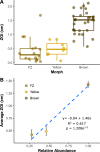Local Adaptation of Bacterial Symbionts within a Geographic Mosaic of Antibiotic Coevolution
- PMID: 31676475
- PMCID: PMC6881802
- DOI: 10.1128/AEM.01580-19
Local Adaptation of Bacterial Symbionts within a Geographic Mosaic of Antibiotic Coevolution
Abstract
The geographic mosaic theory of coevolution (GMC) posits that coevolutionary dynamics go beyond local coevolution and are comprised of the following three components: geographic selection mosaics, coevolutionary hot spots, and trait remixing. It is unclear whether the GMC applies to bacteria, as horizontal gene transfer and cosmopolitan dispersal may violate theoretical assumptions. Here, we test key GMC predictions in an antibiotic-producing bacterial symbiont (genus Pseudonocardia) that protects the crops of neotropical fungus-farming ants (Apterostigma dentigerum) from a specialized pathogen (genus Escovopsis). We found that Pseudonocardia antibiotic inhibition of common Escovopsis pathogens was elevated in A. dentigerum colonies from Panama compared to those from Costa Rica. Furthermore, a Panama Canal Zone population of Pseudonocardia on Barro Colorado Island (BCI) was locally adapted, whereas two neighboring populations were not, consistent with a GMC-predicted selection mosaic and a hot spot of adaptation surrounded by areas of maladaptation. Maladaptation was shaped by incongruent Pseudonocardia-Escovopsis population genetic structure, whereas local adaptation was facilitated by geographic isolation on BCI after the flooding of the Panama Canal. Genomic assessments of antibiotic potential of 29 Pseudonocardia strains identified diverse and unique biosynthetic gene clusters in BCI strains despite low genetic diversity in the core genome. The strength of antibiotic inhibition was not correlated with the presence/absence of individual biosynthetic gene clusters or with parasite location. Rather, biosynthetic gene clusters have undergone selective sweeps, suggesting that the trait remixing dynamics conferring the long-term maintenance of antibiotic potency rely on evolutionary genetic changes within already-present biosynthetic gene clusters and not simply on the horizontal acquisition of novel genetic elements or pathways.IMPORTANCE Recently, coevolutionary theory in macroorganisms has been advanced by the geographic mosaic theory of coevolution (GMC), which considers how geography and local adaptation shape coevolutionary dynamics. Here, we test GMC in an ancient symbiosis in which the ant Apterostigma dentigerum cultivates fungi in an agricultural system analogous to human farming. The cultivars are parasitized by the fungus Escovopsis The ants maintain symbiotic actinobacteria with antibiotic properties that help combat Escovopsis infection. This antibiotic symbiosis has persisted for tens of millions of years, raising the question of how antibiotic potency is maintained over these time scales. Our study tests the GMC in a bacterial defensive symbiosis and in a multipartite symbiosis framework. Our results show that this multipartite symbiotic system conforms to the GMC and demonstrate that this theory is applicable in both microbes and indirect symbiont-symbiont interactions.
Keywords: coevolution; geographic mosaic theory of coevolution; secondary metabolism.
Copyright © 2019 American Society for Microbiology.
Figures





Similar articles
-
The population structure of antibiotic-producing bacterial symbionts of Apterostigma dentigerum ants: impacts of coevolution and multipartite symbiosis.Am Nat. 2012 Nov;180(5):604-17. doi: 10.1086/667886. Epub 2012 Sep 25. Am Nat. 2012. PMID: 23070321 Free PMC article.
-
Genomic insights into the evolution of secondary metabolism of Escovopsis and its allies, specialized fungal symbionts of fungus-farming ants.mSystems. 2024 Jul 23;9(7):e0057624. doi: 10.1128/msystems.00576-24. Epub 2024 Jun 21. mSystems. 2024. PMID: 38904377 Free PMC article.
-
Symbiont-Mediated Protection of Acromyrmex Leaf-Cutter Ants from the Entomopathogenic Fungus Metarhizium anisopliae.mBio. 2021 Dec 21;12(6):e0188521. doi: 10.1128/mBio.01885-21. Epub 2021 Dec 21. mBio. 2021. PMID: 34933458 Free PMC article.
-
Symbiont recruitment versus ant-symbiont co-evolution in the attine ant-microbe symbiosis.Curr Opin Microbiol. 2012 Jun;15(3):269-77. doi: 10.1016/j.mib.2012.03.001. Epub 2012 Mar 23. Curr Opin Microbiol. 2012. PMID: 22445196 Review.
-
Placement of attine ant-associated Pseudonocardia in a global Pseudonocardia phylogeny (Pseudonocardiaceae, Actinomycetales): a test of two symbiont-association models.Antonie Van Leeuwenhoek. 2010 Aug;98(2):195-212. doi: 10.1007/s10482-010-9427-3. Epub 2010 Mar 24. Antonie Van Leeuwenhoek. 2010. PMID: 20333466 Free PMC article. Review.
Cited by
-
Antileishmanial macrolides from ant-associated Streptomyces sp. ISID311.Bioorg Med Chem. 2021 Feb 15;32:116016. doi: 10.1016/j.bmc.2021.116016. Epub 2021 Jan 12. Bioorg Med Chem. 2021. PMID: 33493972 Free PMC article.
-
Assessing Biosynthetic Gene Cluster Diversity of Specialized Metabolites in the Conserved Gut Symbionts of Herbivorous Turtle Ants.Front Microbiol. 2021 Jun 29;12:678100. doi: 10.3389/fmicb.2021.678100. eCollection 2021. Front Microbiol. 2021. PMID: 34267736 Free PMC article.
-
Advances in actinomycete research: an ActinoBase review of 2019.Microbiology (Reading). 2020 Aug;166(8):683-694. doi: 10.1099/mic.0.000944. Epub 2020 Jun 19. Microbiology (Reading). 2020. PMID: 32558638 Free PMC article. Review.
-
Genomic diversification of the specialized parasite of the fungus-growing ant symbiosis.Proc Natl Acad Sci U S A. 2022 Dec 20;119(51):e2213096119. doi: 10.1073/pnas.2213096119. Epub 2022 Dec 12. Proc Natl Acad Sci U S A. 2022. PMID: 36508678 Free PMC article.
-
Streptomyces sp. M54: an actinobacteria associated with a neotropical social wasp with high potential for antibiotic production.Antonie Van Leeuwenhoek. 2021 Apr;114(4):379-398. doi: 10.1007/s10482-021-01520-y. Epub 2021 Feb 15. Antonie Van Leeuwenhoek. 2021. PMID: 33587228
References
-
- Margulis L. 1970. Origin of eukaryotic cells. Yale University Press, New Haven, CT.
Publication types
MeSH terms
Substances
Grants and funding
LinkOut - more resources
Full Text Sources
Other Literature Sources
Medical

